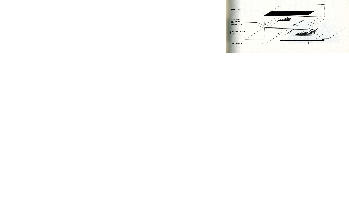Japanese Animation and New Media
Week Eight: Chapter Thirteen: Multiple Frames of Reference
The otaku effect, in which the animation is transformed into an assembly and the consumer is transformed into assembler, happens in the context of limited animation. How does limited television animation invite this otaku effect?
In Introduction to Otakuology, discussing two animated series associated with Miyazaki Hayao (Lupin III and Future Boy Conan), Okada Toshio shows the layout for producing movement in limited animation by sliding the layers of the image.
As we have already discussed, from the time of Castle in the Sky, Miyazaki began more and more resolutely to distance himself from otaku, becoming more critical of anime and otaku, and insisting that his films were manga eiga or ‘manga films.’ Yet his earlier animations were definitely central to the otaku effect, partly due to their inventive action scenes using techniques of limited animation, and partly due to his girl characters. Let’s first consider limited animation.
The importance of limited animation lies in its flattening of the intervals between the layers of the image. Okada’s diagram shows the layers of the image in exploded projection, which makes us aware of the intervals between layers. But, as Murakami Takashi astutely observed, anime tends to suppress the gap between layers, resulting in a superflat image. Or, put another way, the multiplanar image becomes a superplanar image. Depth comes to the surface.
As demonstrated in the contrast between Tabaimo and Miyazaki in chapter 9, as depth comes to the surface, the effect is one of relative movement. There is no fixed frame of reference for movement. Sliding a layer of the image generates a sense of movement, but with a flattened image, we do not have easy recourse to the parallax effect in which things closer to us move faster than those farther from us. Take the opening sequence from Nadia for instance.
The scene begins with something of a Miyazaki feel to it, with a panoramic shot down through drifting clouds on a boat moving up the river. Already the style of landscape drawing is far more schematic than Miyazaki, and the image is flatter. But it is when the scene turns to a lateral view of the boat on the river that we really feel the difference. There is a kind of parallax effect in that the foreground layer is moving faster than the middle ground layer (the boat) and the background (landscape). If you look closely, you’ll notice that the boat layer is not moving. It is the foreground layer of grasses that is being pulled background, which makes it feel as if the boat were moving forward. The background layer is also sliding backward but more slowly than the foreground grasses. As a result, the frame of reference for movement is the boat, the boat layer. Even the birds are in motion. Only the boat is still. In effect, ‘mecha’ is the frame of reference not nature.
In addition, due to the flattening of the gap between layers of the image, the sensation of relative movement is greater than in Miyazaki’s ‘open compositing.’ As such, with this ‘flat compositing,’ we get the feeling that the frame of reference for movement may suddenly change. In other words, the boat is the frame of reference for movement but it is a relative frame of reference.



